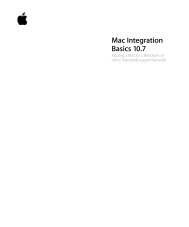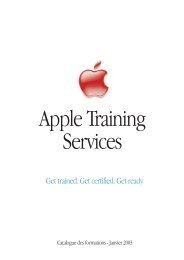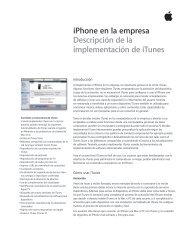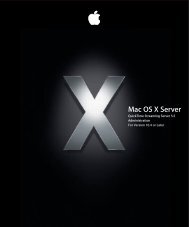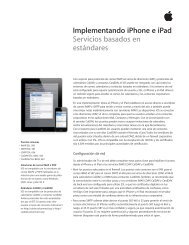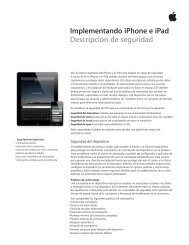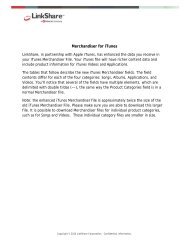In-House App Development Accelerator Guide - Apple
In-House App Development Accelerator Guide - Apple
In-House App Development Accelerator Guide - Apple
You also want an ePaper? Increase the reach of your titles
YUMPU automatically turns print PDFs into web optimized ePapers that Google loves.
With iOS you can deliver content and information in simple, yet powerful new ways to help your<br />
employees be more productive. Leveraging the iOS SDK, your development team will be building<br />
apps using the same tools <strong>App</strong>le engineers use to build the OS and the apps that ship with every<br />
iPhone and iPad. This enables you to create apps that look, feel, and respond to your users elegantly<br />
and with maximum e∑ ciency.<br />
Using iOS tools you can leverage high-level frameworks that help you take full advantage of the<br />
platform. We’ll explore the essential APIs for in-house development to give you ideas for integrating<br />
these capabilities into your apps. We’ll also discuss how you can leverage web technologies by using<br />
HTML5, CSS, and JavaScript. With the right security features built into your solution, these technologies<br />
work together to create a powerful, secure foundation that supports your business needs.<br />
Finally, before you can consider your app ready for users, you’ll want to thoroughly test and debug<br />
it. You’ll also want to validate its performance on di∂ erent devices. We’ll discuss how iOS tools help<br />
you perform those tasks and suggest best practices for making sure your app works the way you<br />
intend it to.<br />
Native <strong>Development</strong><br />
<strong>Development</strong><br />
When it comes to in-house development, it’s all about executing the vision of your app design, taking<br />
full advantage of the device’s capabilities, and doing so in a organized and e∑ cient environment. The<br />
iOS SDK includes Xcode, the IDE for coding, building, and debugging your app; <strong>In</strong>terface Builder for<br />
creating the UI; <strong>In</strong>struments to analyze behavior and performance; and dozens of additional tools.<br />
Xcode is the hub of your development experience. Xcode provides code completion,<br />
real-time static analysis, and instant on-device debugging.<br />
<strong>In</strong>terface Builder makes it simple to prototype your app. Drag elements to create a full user<br />
interface without writing any code. With Xcode 4, <strong>In</strong>terface Builder is built right into the<br />
Xcode IDE.<br />
<strong>In</strong>struments collects and displays data such as disk, memory, or CPU usage in real time,<br />
making it easy to pinpoint problem areas.<br />
The Simulator runs your app in much the same way an iOS device would, so you<br />
can verify and test your code right from your desktop environment.<br />
Planning • Design • <strong>Development</strong> • Deployment<br />
<strong>Development</strong> Checklist<br />
By the end of the development phase, you should have a basic<br />
understanding of:<br />
iOS SDK tools, including Xcode, <strong>In</strong>terface Builder, <strong>In</strong>struments, and Simulator<br />
The key APIs and frameworks for enterprise in-house development<br />
Web app development<br />
iOS architecture for accessing data in back-o∑ ce systems<br />
Best practices for securing your in-house apps<br />
Testing, debugging, and performance validation of your app<br />
“ It is my team’s experience that SDK and Xcode are<br />
fantastic programming tools and very easy to use,<br />
even for developers not coming from a Mac<br />
background.”<br />
—Hans-Christian Pahlig, Axel Springer<br />
17





